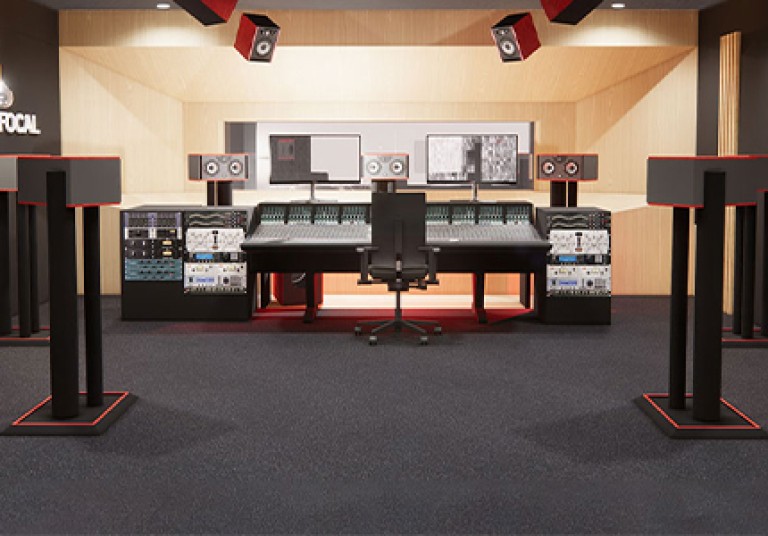SCHEMA
7.1.4 is the minimum preferred Dolby Atmos® layout.
Each number separated by a dot corresponds to a specific height.
A. Monitors at ear level this is 1.2m on average.
B. Subwoofers, ideally placed on the floor.
C. Overhead monitors.
Note: It is, however, possible to add additional audio sources to achieve a 17.X.10 format
(see Dolby Atmos Home Entertainment Studio technical guidelines).
Channel designation

How large should the room be ?
CTA
A Dolby Atmos installation requires a minimum room volume of 50m³.
For an optimal setup, the area that contains the monitors should meet
the following requirements:
A. HEIGHT ≥ 2.4M
B. WIDTH ≥ 3M
C. DEPTH ≥ 3.5M
D. DISTANCE BETWEEN THE MONITORS AND THE MIXING POSITION
< 4M OPTIMAL
< 5M MAX.
Note: These layout dimensions are independent of your room volume.
How to place ear level monitors ?
There are two types of layouts:
The equidistant layout and the orthogonal layout. The choice is mainly based on the space you have available and where your mix position is located.
An orthogonal layout will favor a set back sweet spot as well as a control room with significant depth, whereas an equidistant layout will be more suitable for large rooms and is not subject to time alignment issues between channels.
The center, left, right and surround monitors constitute the first height to be considered for your
setup. The other channels are distributed from angle 0, determined by the center monitor.
The angles of the surround channels depend on the chosen layout.
The acoustic center of each monitor (point where the sound seems to arrive from the speaker) should be 1.2m high.
Note: In an equidistant layout, this distance is the same for all the monitors in your setup.
Optimal equidistant layout




Optimal Orthogonal layout




How to place ceiling monitors ?
The horinzontal postioning
The horizontal positioning of the Top monitors (Ltf, Rtf, Ltr, Rtr) is done in the same way as the monitors at ear level (L, C, R and Surrounds). They surround the mix position which is also the center of the top speaker array. Their acoustic center (point where the sound seems to arrive from the speaker) must be at least 2.4m high and oriented to the mix position at a vertical angle of 45°.
Note: This angle is applicable for Front and surround monitors at ear level with no vertical tilt. We strongly recommend to keep the setup this way.
However, If the front and surround monitors are higher than ear level with a vertical tilt, please refer to the Dolby Atmos Home Entertainment Studio technical guidelines chapter 2.3.4.
SIDE VIEW EQUIDISTANT & ORTHOGONAL LAYOUT

FRONT VIEW EQUIDISTANT & ORTHOGONAL LAYOUT

Optimal equidistant layout




Optimal orthogonal layout




HOW TO PLACE SUBWOOFERS?
The subwoofer should be ideally placed on the floor to improve the frequency response inlow end.
It is also possible to chain and stack several subwoofers for more output level.
HOW DO I CALIBRATE MY SETUP?
The sound level of your setup should be between 79dB(C) and 85dB(C). Once you have chosen your level, each monitor should be measured from the mix position with a measurement microphone or a sonometer. Use the Dolby pink noise to adjust the level of each channel individually. All monitors should have the same level. However, it is possible to adjust your subwoofer by up to 10dB. To manage your monitor level, delay, and tuning you will need a dedicated audio interface. Some of these offer auto calibrations using a measurement microphone. Otherwise, most of them allow you to apply level corrections, filtering, and delays. Make sure that the number of outputs corresponds to your Dolby Atmos® setup.
Alpha Evo Layout

Shape layout

ST6 layout

SM6 Layout

Download

ad guidelines

JOIN THE COMMUNITY
Subscribe to our newsletter and receive a preview of the latest audio innovations from Focal and Naim.
Newsletter
New products and limited editions
Invitations to exclusive events
Benefit from special offers










